ВУЗ: Не указан
Категория: Не указан
Дисциплина: Не указана
Добавлен: 01.04.2021
Просмотров: 1450
Скачиваний: 7
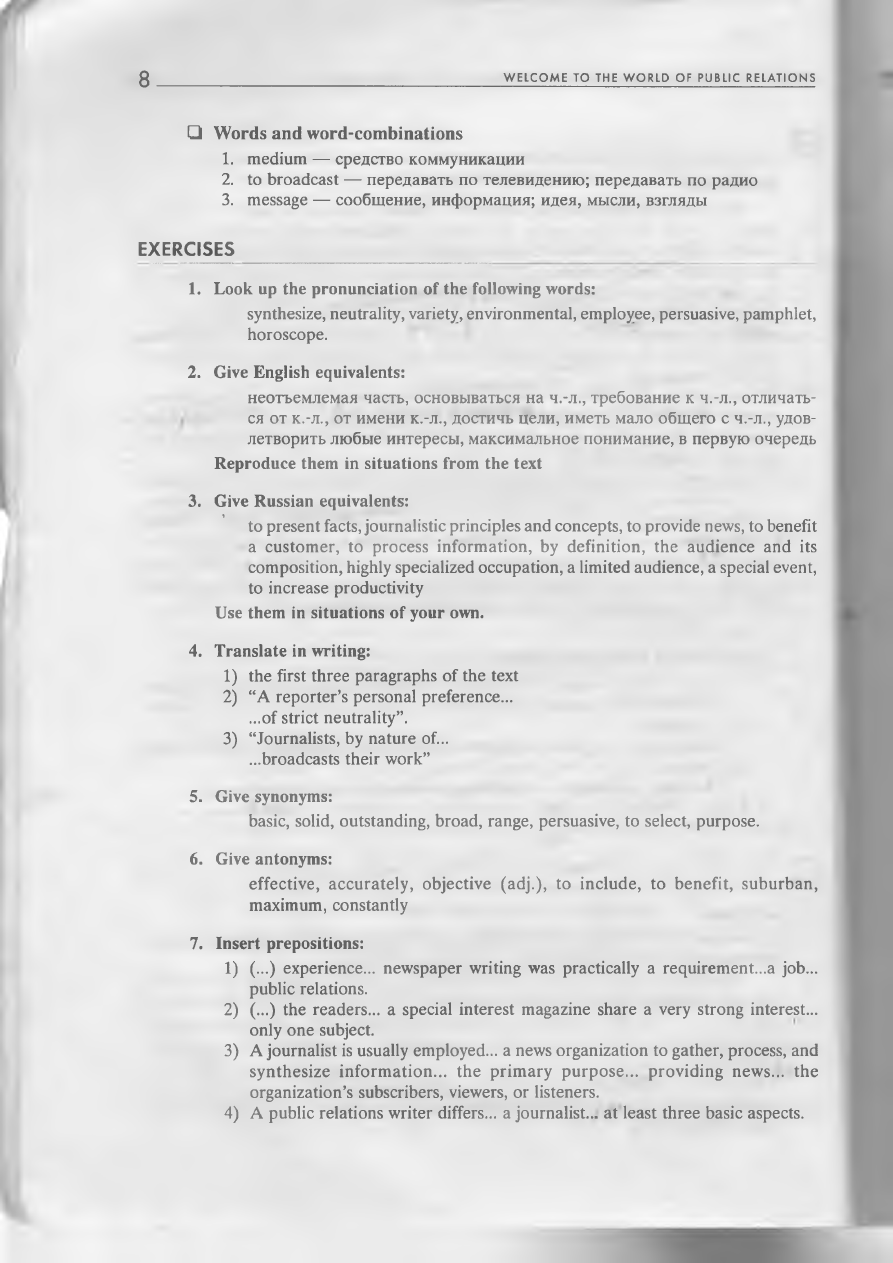
8
W E L C O M E T O T H E W O R L D O F P U B L I C R E L A T I O N S
□ Words and word-combinations
1. medium — средство коммуникации
2. to broadcast — передавать по телевидению; передавать по радио
3. message — сообщение, информация; идея, мысли, взгляды
EXERCISES
1. Look up the pronunciation of the following words:
synthesize, neutrality, variety, environmental, employee, persuasive, pamphlet,
horoscope.
2. Give English equivalents:
неотъемлемая часть, основываться на ч.-л., требование к ч.-л., отличать
ся от к.-л., от имени к.-л., достичь цели, иметь мало общего с ч.-л., удов
летворить любые интересы, максимальное понимание, в первую очередь
Reproduce them in situations from the text
3. Give Russian equivalents:
*
to present facts, journalistic principles and concepts, to provide news, to benefit
a customer, to process information, by definition, the audience and its
composition, highly specialized occupation, a limited audience, a special event,
to increase productivity
Use them in situations of your own.
4. Translate in writing:
1) the first three paragraphs of the text
2) “A reporter’s personal preference...
...of strict neutrality”.
3) “Journalists, by nature of...
...broadcasts their work”
5. Give synonyms:
basic, solid, outstanding, broad, range, persuasive, to select, purpose.
6
. Give antonyms:
effective, accurately, objective (adj.), to include, to benefit, suburban,
maximum, constantly
7. Insert prepositions:
1) (...) experience... newspaper writing was practically a requirement...a job...
public relations.
2) (...) the readers... a special interest magazine share a very strong interest...
only one subject.
3) A journalist is usually employed... a news organization to gather, process, and
synthesize inform ation... the prim ary purpose... providing news... the
organization’s subscribers, viewers, or listeners.
4) A public relations writer differs... a journalist... at least three basic aspects.
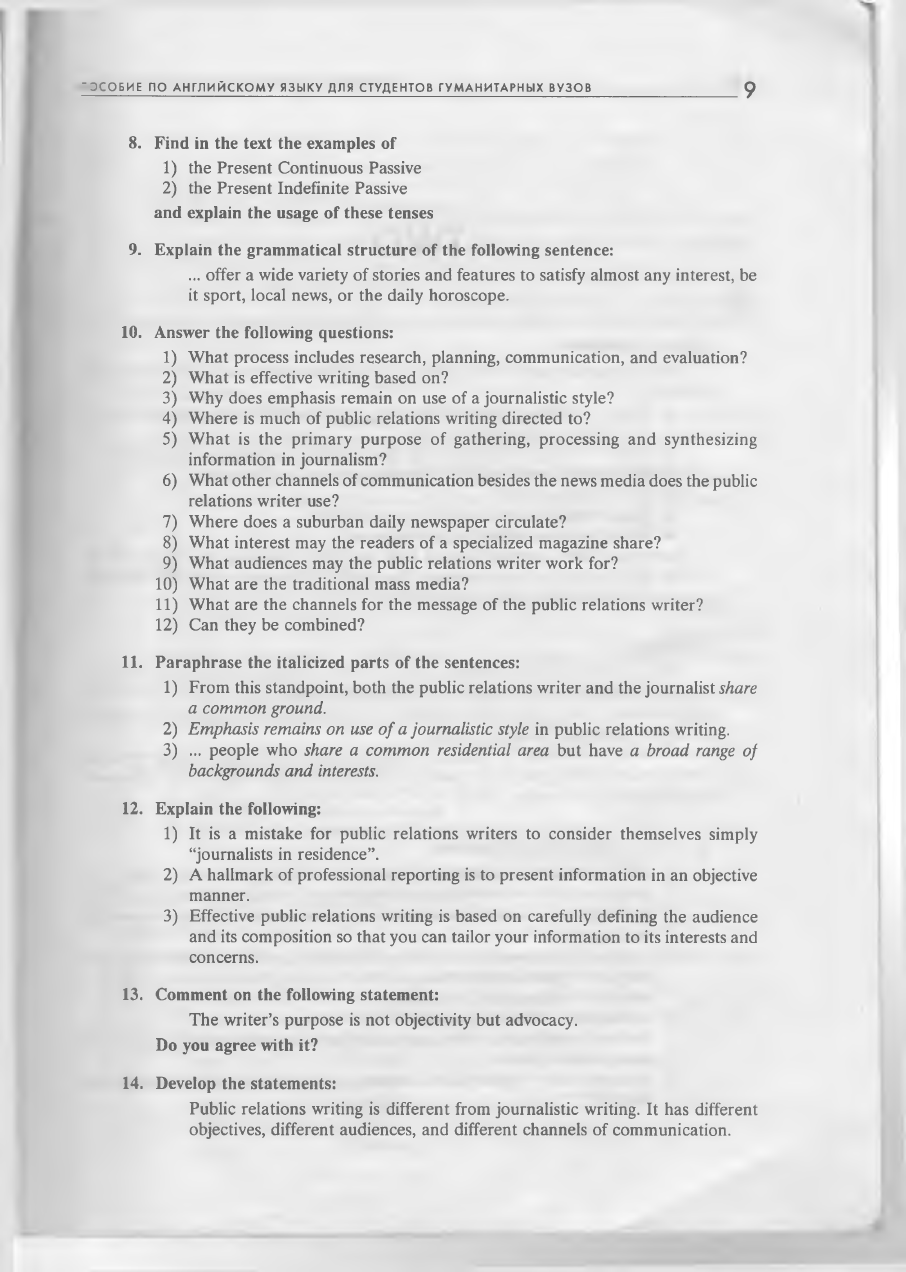
~ З С О Б И Е П О А Н Г Л И Й С К О М У Я З Ы К У Д Л Я С Т У Д Е Н Т О В Г У М А Н И Т А Р Н Ы Х В У З О В
9
8
. Find in the text the examples of
1) the Present Continuous Passive
2) the Present Indefinite Passive
and explain the usage of these tenses
9. Explain the grammatical structure of the following sentence:
... offer a wide variety of stories and features to satisfy almost any interest, be
it sport, local news, or the daily horoscope.
10. Answer the following questions:
1) What process includes research, planning, communication, and evaluation?
2) What is effective writing based on?
3)
Why does emphasis remain on use of a journalistic style?
4) Where is much of public relations writing directed to?
5) W hat is the primary purpose of gathering, processing and synthesizing
information in journalism?
6) What other channels of communication besides the news media does the public
relations writer use?
7) Where does a suburban daily newspaper circulate?
8) What interest may the readers of a specialized magazine share?
9) What audiences may the public relations writer work for?
10) What are the traditional mass media?
11) What are the channels for the message of the public relations writer?
12) Can they be combined?
11. Paraphrase the italicized parts of the sentences:
1) From this standpoint, both the public relations writer and the journalist
share
a common ground.
2)
Emphasis remains on use o f a journalistic style
in public relations writing.
3)
... people who
share a common residential area
but have
a broad range of
backgrounds and interests.
12. Explain the following:
1) It is a mistake for public relations writers to consider themselves simply
“journalists in residence”.
2) A hallmark of professional reporting is to present information in an objective
manner.
3)
Effective public relations writing is based on carefully defining the audience
and its composition so that you can tailor your information to its interests and
concerns.
13. Comment on the following statement:
The writer’s purpose is not objectivity but advocacy.
Do you agree with it?
14. Develop the statements:
Public relations writing is different from journalistic writing. It has different
objectives, different audiences, and different channels of communication.
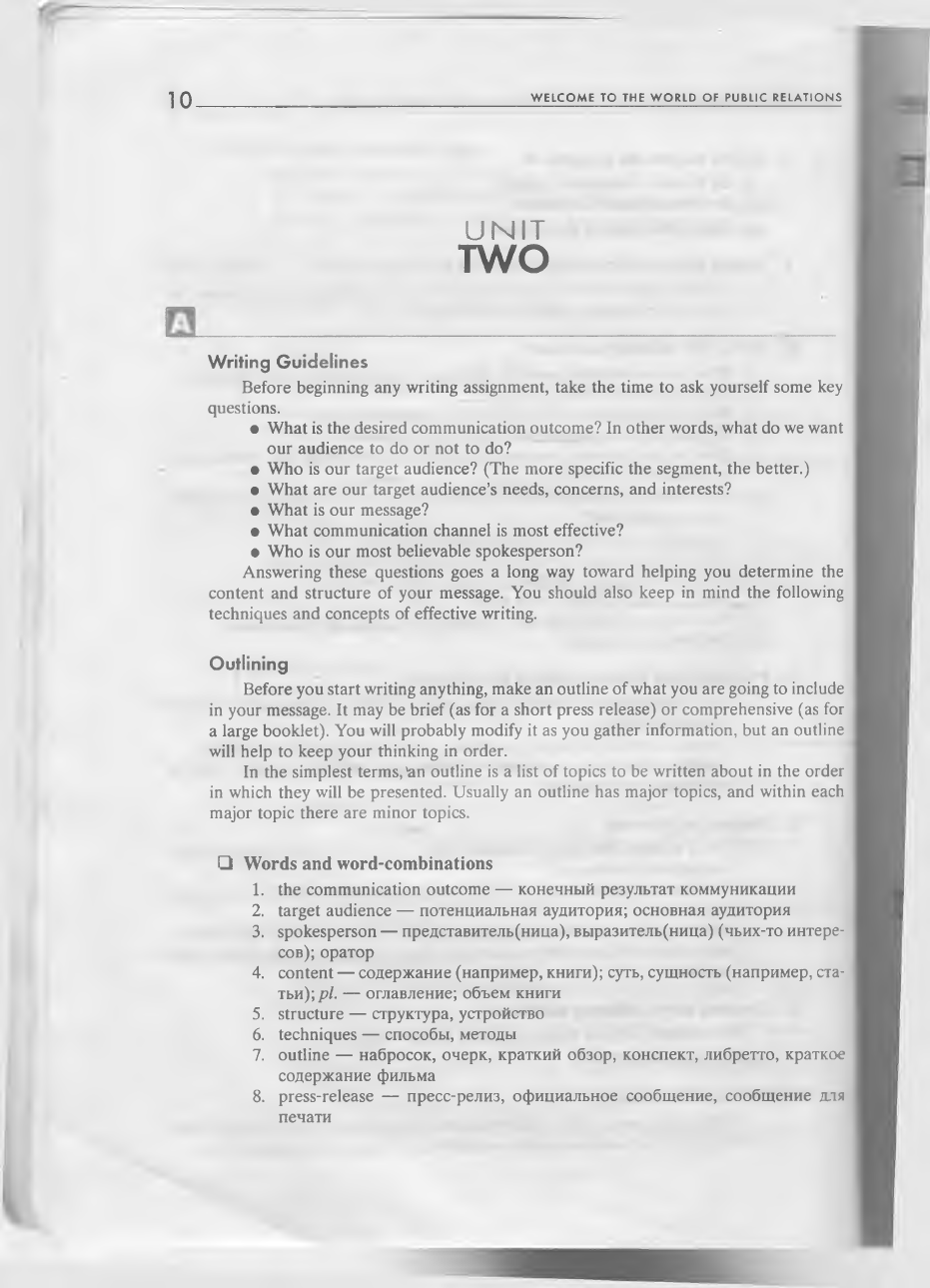
10
W E L C O M E T O T H E W O R L D O F P U B L I C R E L A T I O N S
U N I T
TWO
Writing Guidelines
Before beginning any writing assignment, take the time to ask yourself some key
questions.
• What is the desired communication outcome? In other words, what do we want
our audience to do or not to do?
• Who is our target audience? (The more specific the segment, the better.)
• What are our target audience’s needs, concerns, and interests?
• What is our message?
• What communication channel is most effective?
• Who is our most believable spokesperson?
Answering these questions goes a long way toward helping you determine the
content and structure of your message. You should also keep in mind the following
techniques and concepts of effective writing.
Outlining
Before you start writing anything, make an outline of what you are going to include
in your message. It may be brief (as for a short press release) or comprehensive (as for
a large booklet). You will probably modify it as you gather information, but an outline
will help to keep your thinking in order.
In the simplest terms,'an outline is a list of topics to be written about in the order
in which they will be presented. Usually an outline has major topics, and within each
major topic there are minor topics.
□ Words and word-combinations
1. the communication outcome — конечный результат коммуникации
2. target audience — потенциальная аудитория; основная аудитория
3. spokesperson — представитель(ница), выразитель(ница) (чьих-то интере
сов); оратор
4. content — содержание (например, книги); суть, сущность (например, ста
тьи);
pi.
— оглавление; объем книги
5. structure — структура, устройство
6. techniques — способы, методы
7. outline — набросок, очерк, краткий обзор, конспект, либретто, краткое
содержание фильма
8. press-release — пресс-релиз, официальное сообщение, сообщение для
печати
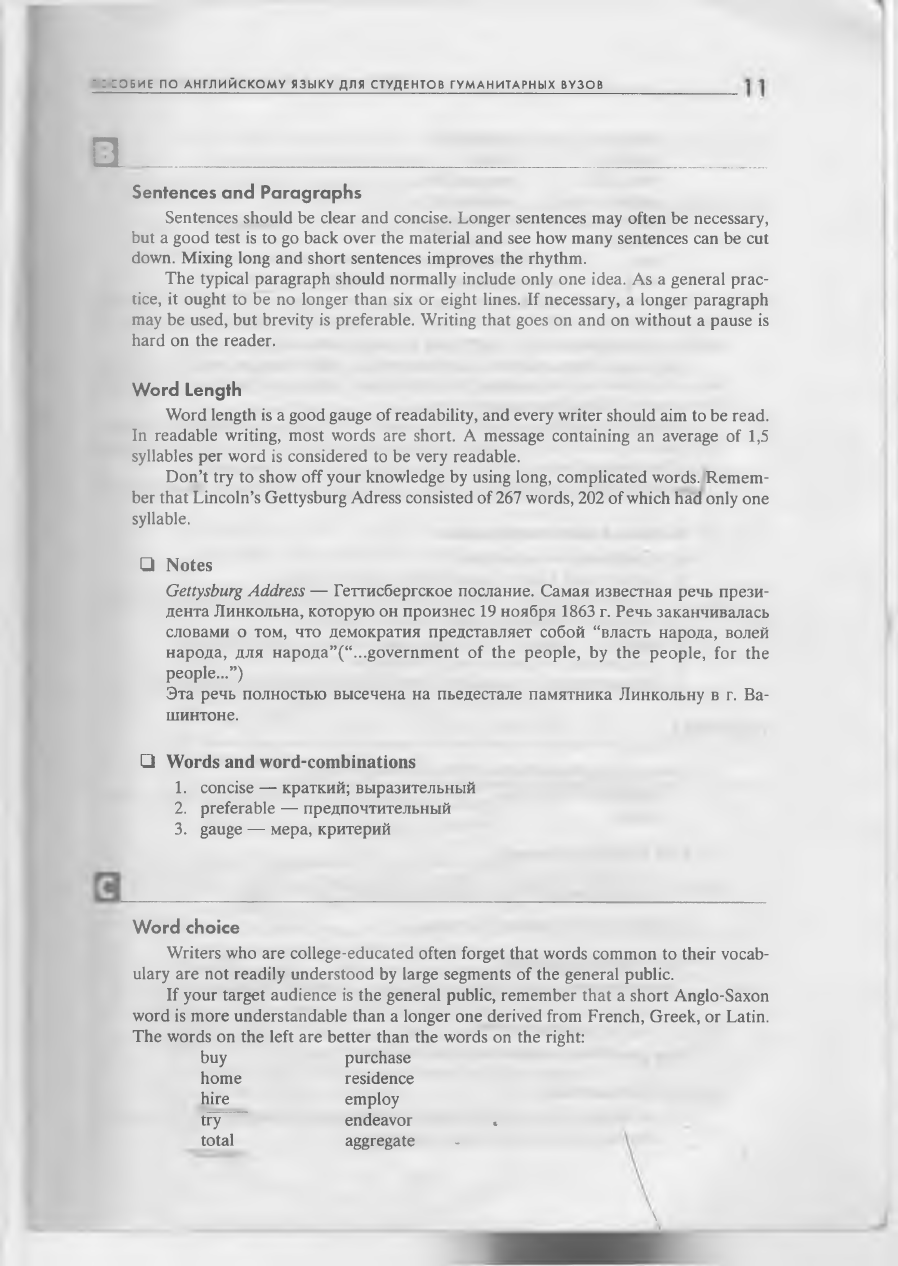
• : 1 3 Б И Е П О А Н Г Л И Й С К О М У
я з ы к у
д л я
с т у д е н т о в
г у м а н и т а р н ы х
в у з о в
[ 1
_________________________________________________________________________________
Sentences and Paragraphs
Sentences should be clear and concise. Longer sentences may often be necessary,
but a good test is to go back over the material and see how many sentences can be cut
down. Mixing long and short sentences improves the rhythm.
The typical paragraph should normally include only one idea. As a general prac
tice, it ought to be no longer than six or eight lines. If necessary, a longer paragraph
may be used, but brevity is preferable. Writing that goes on and on without a pause is
hard on the reader.
Word Length
Word length is a good gauge of readability, and every writer should aim to be read.
In readable writing, most words are short. A message containing an average of 1,5
syllables per word is considered to be very readable.
D on’t try to show off your knowledge by using long, complicated words. Remem
ber that Lincoln’s Gettysburg Adress consisted of 267 words, 202 of which had only one
syllable.
□ Notes
Gettysburg Address
— Геттисбергское послание. Самая известная речь прези
дента Линкольна, которую он произнес 19 ноября 1863 г. Речь заканчивалась
словами о том, что демократия представляет собой “власть народа, волей
народа, для народа”(“...government of the people, by the people, for the
people...”)
Эта речь полностью высечена на пьедестале памятника Линкольну в г. Ва-
шинтоне.
□ Words and word-combinations
1. concise — краткий; выразительный
2. preferable — предпочтительный
3. gauge — мера, критерий
Word choice
Writers who are college-educated often forget that words common to their vocab
ulary are not readily understood by large segments of the general public.
If your target audience is the general public, remember that a short Anglo-Saxon
word is more understandable than a longer one derived from French, Greek, or Latin.
The words on the left are better than the words on the right:
buy
purchase
home
residence
hire
employ
try
endeavor
*
total
aggregate
Ы
.
\
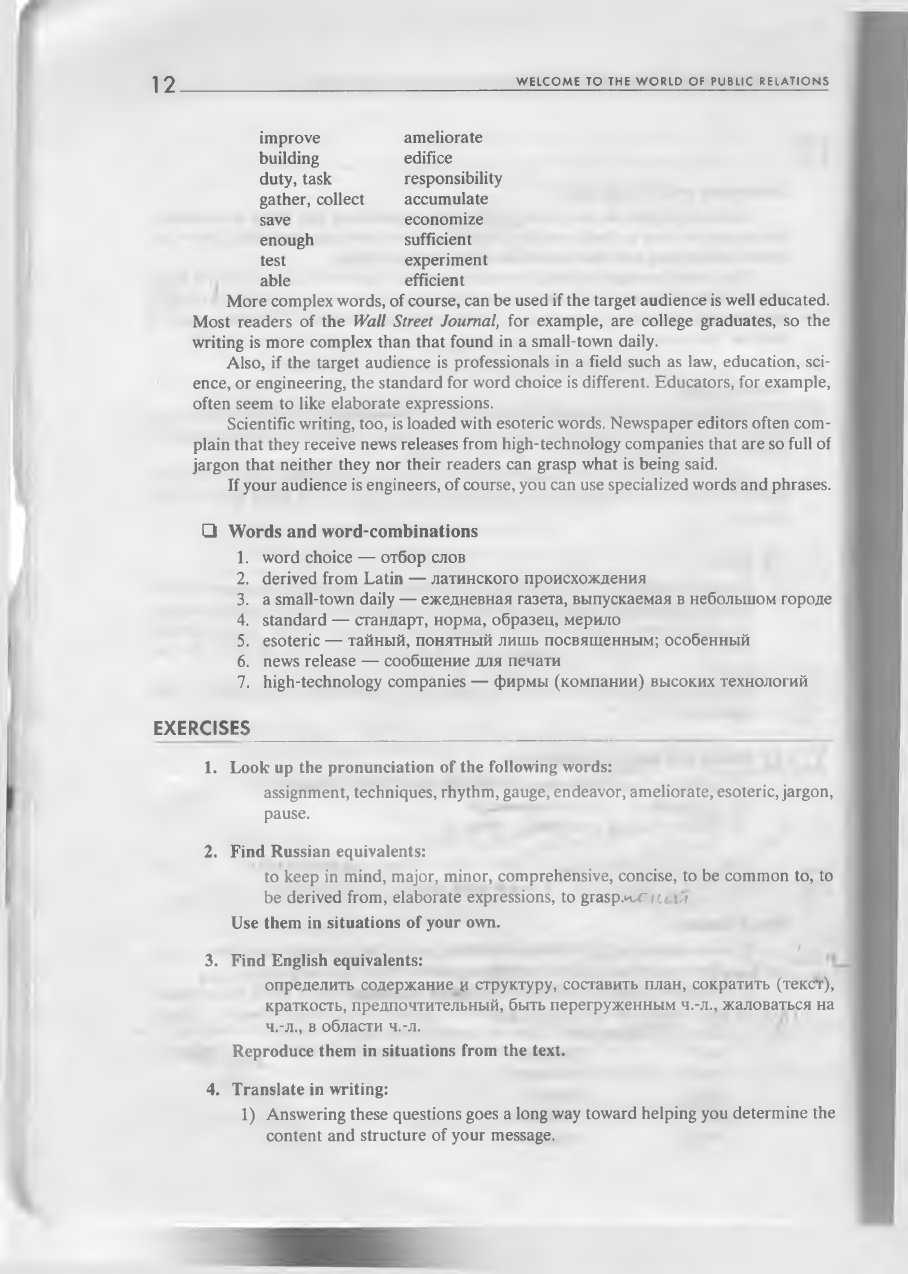
12
W E L C O M E T O T H E W O R L D O F P U B L I C R E L A T I O N S
improve
ameliorate
building
edifice
duty, task
responsibility
gather, collect
accumulate
save
economize
enough
sufficient
test
experiment
able
efficient
More complex words, of course, can be used if the target audience is well educated.
Most readers of the
Wall Street Journal,
for example, are college graduates, so the
writing is more complex than that found in a small-town daily.
Also, if the target audience is professionals in a field such as law, education, sci
ence, or engineering, the standard for word choice is different. Educators, for example,
often seem to like elaborate expressions.
Scientific writing, too, is loaded with esoteric words. Newspaper editors often com
plain that they receive news releases from high-technology companies that are so full of
jargon that neither they nor their readers can grasp what is being said.
If your audience is engineers, of course, you can use specialized words and phrases.
□ Words and word-combinations
1. word choice — отбор слов
2. derived from Latin — латинского происхождения
3. a small-town daily — ежедневная газета, выпускаемая в небольшом городе
4. standard — стандарт, норма, образец, мерило
5. esoteric — тайный, понятный лишь посвященным; особенный
6. news release — сообщение для печати
7. high-technology companies — фирмы (компании) высоких технологий
EXERCISES
1. Look up the pronunciation of the following words:
assignment, techniques, rhythm, gauge, endeavor, ameliorate, esoteric, jargon,
pause.
2. Find
Russian equivalents:
'
to keep in mind, major, minor, comprehensive, concise, to be common to, to
be derived from, elaborate expressions, to grasp>a~f^
f t
Use them in situations of your own.
t
3. Find English equivalents:
определить содержание и структуру, составить план, сократить (текст),
краткость, предпочтительный, быть перегруженным ч.-л., жаловаться на
ч.-л., в области ч.-л.
Reproduce them in situations from the text.
4. Translate in writing:
1) Answering these questions goes a long way toward helping you determine the
content and structure of your message.